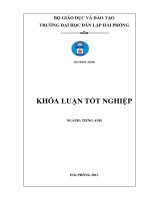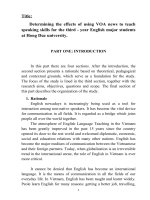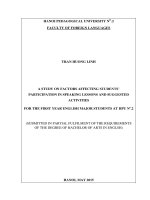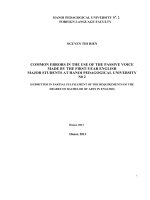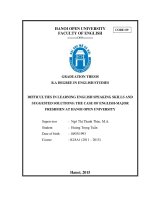The difficulties in learning speaking skills encountered by the first year english major students at hanoi open university
Bạn đang xem bản rút gọn của tài liệu. Xem và tải ngay bản đầy đủ của tài liệu tại đây (849.62 KB, 54 trang )
HANOI OPEN UNIVERSITY
FACULTY OF ENGLISH
GRADUATION THESIS
B.A DEGREE IN ENGLISH STUDY
THE DIFFICULTIES IN LEARNING SPEAKING SKILLS
ENCOUNTERED BY THE FIRST YEAR ENGLISH MAJOR
STUDENTS AT HANOI OPEN UNIVERSITY
Supervisor
: Assoc. Prof. Dr. Hoang Tuyet Minh
Name of student : Pham Thuy Duong
Date of birth
: 26/01/1994
Class
: 1271A04 (2012-2016)
Hanoi - 2016
Graduation Paper
DECLARATION
TITLE: THE DIFFICULTIES IN LEARNING SPEAKING SKILLS
ENCOUNTERED BY THE FIRST YEAR ENGLISH MAJOR
STUDENTS AT HOU
(Graduation Paper submitted in Partial Fulfillment for B.A Degree in English)
I certify that no part of the above report has been copied and reproduced me
from any other person’s work without acknowledgement and that the report is
originally written by me under strict and enthusiastic guidance of my
supervisor.
Hanoi, 15th April 2016
Student
Supervisor
Pham Thuy Duong
Hoang Tuyet Minh
Phạm Thùy Dương – 1271A04- (2012- 2016)
Graduation Paper
ACKNOWLEDGEMENT
First and foremost, I would like hereby to extend my profound gratitude to my
supervisor, Mrs Hoang Tuyet Minh, Assoc. Pro. Dr. Hoang Tuyet Minh from
whom I have received enormous kindness and guidance. Without her
encouragement and assistance, I could not have finished this research paper.
I also would like to take this opportunity to express my sincere thanks to all
the teachers at the English Faculty of Hanoi Open University for their
interesting and useful lectures which have built in me a firm foundation with
immense ideas for the fulfillment of this paper.
In particular, my deepest gratitude goes to my parents who have, as it always
goes, encouraged and supported me so much in all aspects.
Phạm Thùy Dương – 1271A04- (2012- 2016)
Graduation Paper
TABLE OF CONTENT
PART A: INTRODUCTION ....................................................................... 1
1. Rationale .................................................................................................... 1
2. Aims of the study ....................................................................................... 2
3. Scope of the study ...................................................................................... 2
4. Methods of the study .................................................................................. 2
5. Research questions ..................................................................................... 2
6. Design of the study ..................................................................................... 3
PART B: DEVELOPMENT ........................................................................ 4
CHAPTER 1: LITERATURE REVIEW .................................................... 4
1.1. Speaking .................................................................................................. 4
1.1.1. Definition .......................................................................................... 4
1.1.2. The importance of speaking .............................................................. 4
1.2. Language learning strategies ................................................................... 5
1.2.1. Definitions of language learning strategies ........................................ 5
1.2.2. Classification of language learning strategies .................................... 6
1.3. Speaking learning strategies .................................................................. 11
1.4. Methods of teaching speaking skills ...................................................... 14
1.4.1. Why teaching speaking is important? .............................................. 14
1.4.2. Methods of teaching speaking ......................................................... 14
1.4.2.1. Direct method ............................................................................ 14
1.4.2.2. Audio-Lingual method (ALM) .................................................. 16
1.4.2.3. Communicative language teaching (CLT) ................................. 18
1.5. Error analysis ........................................................................................ 20
1.5.1. Definition of errors .......................................................................... 20
1.5.2. Errors in the speech process............................................................. 21
1.5.2.1. Pronunciation error: ................................................................... 21
Phạm Thùy Dương – 1271A04- (2012- 2016)
Graduation Paper
1.5.2.2. Grammatical errors .................................................................... 22
1.5.2.3. Vocabulary errors ...................................................................... 23
1.6. Conclusion ............................................................................................ 23
CHAPTER 2: THE STUDY .................................................................... 324
2.1. Methodology ......................................................................................... 24
2.1.1. Survey ............................................................................................. 24
2.1.1.1. Questionnaire ............................................................................ 24
2.1.1.2. The subjects ............................................................................... 24
2.1.2. Procedure ........................................................................................ 25
2.2. Results ................................................................................................... 25
2.3. Conclusion ............................................................................................ 29
CHAPTER 3: FINDINGS AND DISCUSSION........................................ 30
3.1. Actual difficulties that the first year English major students at HOU
commit when learning speaking skills .......................................................... 30
3.1.1. The lack of self-confidence ............................................................. 30
3.1.2. The lack of vocabulary .................................................................... 30
3.1.3. The confusion of pronouncing and using grammar .......................... 30
3.1.4. The lack of background knowledge and culture ............................... 31
3.2. Probable causes of making errors .......................................................... 32
3.3. Suggested ways of overcoming the problems ........................................ 33
3.3.1. Some suggestions for learning speaking .......................................... 33
3.3.1.1. Improving self-confidence ......................................................... 33
3.3.1.2. Group work ............................................................................... 35
3.3.1.3. Individual work ......................................................................... 36
3.3.1.3.1. Improving grammar ............................................................. 36
3.3.1.3.2. Improving pronunciation ..................................................... 36
3.3.1.3.3. Vocabulary enlargement ...................................................... 37
Phạm Thùy Dương – 1271A04- (2012- 2016)
Graduation Paper
3.3.1.3.4. Improving speaking through reading ................................... 37
3.3.2. Some suggestions for teaching speaking .......................................... 38
3.3.2.1. Teaching speaking strategies ..................................................... 38
3.3.2.2. Some suggested activities .......................................................... 39
3.4. Summary ............................................................................................... 41
PART C: CONCLUSION .......................................................................... 42
REFERENCES ........................................................................................... 43
APPENDIX 1 .............................................................................................. 45
SURVEY QUESTIONNAIRE ................................................................... 45
APPENDIX 2 .............................................................................................. 47
SOME REFERENCE WEBSITES ........................................................... 47
Phạm Thùy Dương – 1271A04- (2012- 2016)
Graduation Paper
LIST OF FIGURES AND TABLES
Table 1: Direct learning strategies ................................................................. 9
Table 2: Indirect learning strategies ............................................................ 11
Table 3: Language learning strategies useful for speaking skills: ................ 13
Table 2: Difficulties encountered during speaking process .......................... 26
Table 3: Factor in English speaking is difficult ............................................ 26
Table 4: How grammar affect students when speaking English .................... 27
Table 5: Probable causes of making errors .................................................. 27
Table 6-7-8: Suggestions for learning speaking skills .................................. 28
Table 9-10: Suggestions for teaching speaking skill ..................................... 29
Phạm Thùy Dương – 1271A04- (2012- 2016)
PART A: INTRODUCTION
1. Rationale
It is irrefutable that the importance of English in today’s global world
since English is the most common language spoken everywhere. With the
succor of cutting-edge technology, English is of significant value in many
sectors including education, engineering, medicine…Particularly, English is
the chief language in international relations and diploma. The information on
means of media, today, - such as the Internet, television and the press is
uploaded in this global tongue. Magazines, newspaper and books are written
and translated into English. Therefore, this language is the key to access a
reservoir of knowledge of humankind. As a result of comprehension of
international language, not only do human beings have chances to approach
new culture, open their vision but also reach the zenith of success as well. We
easily land high-paid jobs which are related to international communication
and world-wide data sharing. It is really essential for students to know
English.
Language is one of the most powerful tools in human communication. It
is established to maintain contact, gives us identity, personality, social status
and creates communities. By speaking, we can express our feelings, attitudes,
give others information. Hence, speaking is one of the most important skills in
learning another language. However, this process of speaking another
language is far from easy. There still exist many difficulties in learning
speaking skills facing English Language learners in Vietnam in general and
English Language ones at HOU in particular. Although many learners can
write and read English quite well, hardly do they speak fluently and correctly.
I have recognized some big obstacles such as: limited vocabulary, the lack of
Phạm Thùy Dương – 1271A04- (2012- 2016)
1
self-confidence or the poor comprehension on the part of the listeners which
prevent English Language learners at HOU from reaching their aims.
Therefore, this study focus on clarifying the difficulties in learning
English speaking skills encountered by the first year English major students at
HOU as well as to find out solutions, teaching and learning methodologies to
improve the quality of the learning of speaking skills.
2. Aims of the study
This study is aimed at identifying the obstacles of the first year English
students at HOU encounter when learning speaking and suggesting ways of
overcoming in order to enhance the quality of learning and teaching speaking
skills.
3. Scope of the study
The research focuses on finding out learning methods, teaching methods
of speaking skills and the difficulties that the first year English major students
face when learning speaking skills at HOU and suggests several solutions
which help them improve the quality of their learning.
4. Methods of the study
In order to shed light on the aims of the study, quantitative method is
used. Then the data will be synthesized and analyzed to help find out
students’ problems and the tips for improving their weakness.
5. Research questions
This study aims at improving the quality of learning and teaching
speaking skills for the first year English major students at HOU. Therefore,
the following questions need answering:
- What are the problems that H.O.U learners encounter in learning speaking
skills?
Phạm Thùy Dương – 1271A04- (2012- 2016)
2
- How to improve the quality of learning speaking skills to the first year
English major students at HOU?
- How to improve the quality of teaching speaking skills to the first year
English major students at HOU?
6. Design of the study
The study consists of 3 parts:
Part A: Introduction
This part presents the rationale, the aims, the scope, the method, research
questions and the design of the study.
Part B: Development
This part consists of 3 chapters
- Chapter I – Literature Review – deals with the concepts relevant to the
study: methods of learning speaking, methods of teaching speaking and error
analysis.
- Chapter II –The study – provides a questionnaire analysis on the current
situation of learning speaking skills and HOU students’ specific errors.
- Chapter III –Findings and Discussion – Indicate actual errors that learners
commit when learning speaking skills and suggest solutions to improve the
quality of learning and teaching speaking.
Part C: Conclusion - The final part is to summarize all the key issues of the
study and suggestions for further research.
Phạm Thùy Dương – 1271A04- (2012- 2016)
3
PART B: DEVELOPMENT
CHAPTER 1: LITERATURE REVIEW
This chapter briefly covers the theories related to the study: definition of
speaking, definitions of language learning strategies, classifications of
learning strategies, methods of teaching speaking, error analysis.
1.1.
Speaking
1.1.1. Definition
Speaking is an interactive process of constructing meaning that involves
producing and receiving and processing information (Brown, 1994; Burn &
Joyce, 1997). Speaking is a means of communication in expressing ideas,
information and feeling to others. It is the most essential way in which the
speaker can express himself through a language. Brown states that speaking is
literally defined as to say things, express thought aloud, and uses the voice.
Speaking is a productive skill, like writing. It involves using speech to
express meanings to other people (Spratt, 2005). Because speaking is such as
a complex skill, learners may need a lot to help to prepare for speaking.
Practice of necessary vocabulary, time to organize their ideas and what they
want to say, practice in pronouncing new words and expressions, practice in
carrying out a task, before they speak freely. Learners, especially beginners
and children may need time to take in and process all the new language they
hear before they produce it in speaking.
Speaking is words to state and give the ideas and feelings. Speaking is a
mean for communicating ideas. This arranged and develops with listener’s
need (Webster, 1980).
1.1.2. The importance of speaking
Human being as social creature always communicates to one another. It
can be occurred with the process of interchange of the thought or ideas which
Phạm Thùy Dương – 1271A04- (2012- 2016)
4
include interactions. For examples telling information or some news, asking
others helps for their needs, or etc. All of them can be done through speaking
to others directly. It means that the activity of speaking itself has a very
important role in human life.
Ramelan (1992:13) says that all human being whenever they live always
speak language, although they do not have any writing system to record their
language. Thus, speaking is of significant value in mastering foreign
language.
The capacity to express one’s thought, opinions and feelings, in the form
of words put together in a meaningful way, provides the speaker with these
advantages. The joy of sharing ones’ ideas with others is immense. When we
speak to others, we come to have a better understanding of our own selves, as
Robert Frost once said: “ I am a writer of books in retrospect, I talk in order to
understand, I teach in order to learn,” Undoubtedly, the clarify in speech
reflects clear thinking.
An effective speaker can gain the attention of the audience and hold it till
the completion of his message. Speaking skills are important for career
success, but certainly not limited to ones’ professional aspirations. Speaking
skills can also enhance one’s personal life.
1.2.
Language learning strategies
1.2.1. Definitions of language learning strategies
The term “strategy” comes from the ancient Greek word strategia
meaning “generalship” or “the art of war”. The expression implies
characteristics of planning, competition, conscious manipulation, and
movement towards a goal. In education, this concept has taken on a new
meaning and it has been transformed into learning strategies (Oxford, 1990).
Phạm Thùy Dương – 1271A04- (2012- 2016)
5
Wenden and Rubin (1987 cited in Mattarima and Hamdan, 2011, p.104)
define learning strategies as “….any sets of operations, steps, plans, routines
used by the learner to facilitate the obtaining, storage, retrieval, and use of
information.”
In the 2000s, more definitions of strategies appeared in the literature.
Brown (2000, p.122) defined language learning strategies as “the moment-bymoment techniques that we employ to solve ‘problems’ posed by second
language input and output.”
A recent definition claims that language learning strategies are “the
learner’s goal-directed actions for improving language proficiency or
chievement, completing a task, or making learning more efficient, more
effective, and easier (Oxford, 2001b, p. 167).
1.2.2. Classification of language learning strategies
In the literature, like the definition of learning strategies, learning
strategies are classified differently by different scholars.
Wenden (1991:18) divides learning strategies into two broad groups as
follows:
• Cognitive strategies
• Self-management strategies.
In her explanation, cognitive strategies are mental steps or operations
learners use to process both linguistic and sociolinguistic content. Selfmanagement strategies are used to oversee and manage the learner’s learning.
She notes that in cognitive psychology self-management strategies are called
metacognitive or regulatory strategies.
Rubin, who pioneered much of the work in the field of strategies, make
the distinction between strategies contributing directly to learning and those
contributing indirectly to learning. According to Rubin (1987), there are three
Phạm Thùy Dương – 1271A04- (2012- 2016)
6
types of strategies used by learners that contribute directly and indirectly to
language learning. These are:
• Learning strategies
• Communication strategies
• Social strategies
Learning strategies include two main types: cognitive learning strategies
and metacognitive learning strategies. Cognitive learning strategies refer to
the steps or operations used in learning or problem solving that require direct
analysis, transformation or synthesis of learning materials. Rubin identifies 6
main cognitive learning strategies contributing directly to language learning.
They
are
clarification/verification,
monitoring,
memorization,
guessing/inductive inferencing, deductive reasoning and practice. The indirect
strategies include creating opportunities for practice and productions tricks.
According to Stern (1992), there are five main language learning
strategies. These are as follows:
• Management and planning strategies.
• Cognitive strategies
• Communicative -Experiential strategies
• Interpersonal strategies
• Affective strategies
Oxford (1990:9) sees the aims of language learning strategies as being
oriented towards the development of communicative competence. Oxford
divides the language learning strategies into main classes, direct and indirect,
which are further divided into 6 subgroups. In Oxford’s system,
metacognitive strategies help learners regulate their learning. Affective
strategies are concerned with the learner’s emotional requirements such as
confidence, while social strategies lead to increased interaction with the target
Phạm Thùy Dương – 1271A04- (2012- 2016)
7
language. Cognitive strategies are the mental strategies the learners use to
make sense of their learning, memory strategies are those used to the storage
of information, and compensation strategies help learners overcome their
knowledge gaps to continue the communication
Oxford’s (1990:17) taxonomy of language learning strategies is shown in
the following:
Class
Set of strategies
Specific strategies
1. Grouping
a. Creating mental
2. Associating/Elaborating
linkage
3. Placing new words into a
context
1. Using imaginary
I. Memory strategies
b. Applying images
and sounds
2. Semantic mapping
3. Using key words
4. Representing sounds in
memory.
c. Reviewing well
1. Structured reviewed
1. Using physical response or
d. Employing action
sensation
2. Using mechanical
techniques
1. Repeating
2. Formally practicing with
sounds and writing systems
a. Practicing
3. Recognizing and using
formulas and patterns
4. Recombining
5. Practicing naturalistically
Phạm Thùy Dương – 1271A04- (2012- 2016)
8
II.
Cognitive
strategies
1. Getting the idea quickly
b. Receiving and
2. Using resources for
sending messages
receiving and sending
messages
1. Reasoning deductively
2. Analyzing expressions
c. Analyzing and
3. Analyzing contrastively
reasoning
(across languages)
4. Translating
5. Transferring
d. Creating structure
for input and output
1. Taking notes
2. Summarizing
3. Highlighting
a. Guessing
1. Using linguistic clues
intelligently
2. Using other clues
1. Switching to the mother
tongue
2. Getting help
III.
Compensation
3. Using mime or gestures
Strategies
b. Overcoming
limitations in speaking
and writing
4. Avoiding communication
partially of totally
5. Selecting the topic
6. Adjusting or
approximating the message
7. Coining words
8. Using a circumlocution or
synonym
Table 1: Direct learning strategies
(Source: Oxford (1990:18)
Phạm Thùy Dương – 1271A04- (2012- 2016)
9
Group
Set of strategies
Specific strategies
1. Overviewing and lining
a. Centering your
with already known material
learning
2. Paying attention
3. Delaying speech
1. Finding out about
language learning
2. Organizing
b. Arranging and
I. Metacognitive
planning your learning
strategies
3. Setting goals and
objectives
4. Identifying the purpose of
language task (purposeful
listening /
reading/speaking/writing)
5. Planning your task
6. Seeking practice
opportunities
c. Evaluating your
1. Self-monitoring
learning
2. Self-evaluating
1. Using progressive
relaxation, deep breathing, or
a. Lowering your anxiety mediation
2. Using music
3. Using laughter
1. Making positive
II. Affective
b. Encouraging yourself
Phạm Thùy Dương – 1271A04- (2012- 2016)
statements
10
strategies
2. Taking risks wisely
3. Rewarding yourself
1. Listening to your body
2. Using checklist
c. Taking your emotional
temperature
3.Writing a language learning
diary
4. Discussing your feelings
with someone else.
1. Asking for clarification or
a. Asking questions
verification
2. Asking for correction
1. Cooperating with peers
III. Social
b. Cooperating with
2. Cooperating with
others
proficient users of the new
strategies
language
1. Developing cultural
c. Empathizing with
understanding
others
2. Becoming aware of others’
thoughts and feelings
Table 2: Indirect learning strategies
(Source: Oxford (1990:20)
1.3.
Speaking learning strategies
Oxford (1990) further claims that 46 out of 62 strategies from whole strategy
taxonomy are useful for the learning of speaking. The strategies are
summarized in table 3 below:
Phạm Thùy Dương – 1271A04- (2012- 2016)
11
Item
Strategy
Group
1
Placing new words into a context
2
Representing sounds in memory
3
Structured reviewing
4
Repeating
5
Formally practising with sounds and writing
Memory
systems
6
Recognizing and using formulas and patterns
7
Recombining
8
Practising naturalistically
9
Using
resources
for
receiving
and
Cognitive
sending
messages
10
Reasoning deductively
11
Translating
12
Transferring
13
Switching to the mother tongue
14
Getting help
15
Using mime or gesture
16
Avoiding communication partially or totally
17
Selecting the topic
18
Adjusting or approximating the message
19
Coining words
20
Using a circumlocution or synonym
21
Overviewing and linking with already known
Compensation
material
22
Paying attention
Phạm Thùy Dương – 1271A04- (2012- 2016)
12
23
Delaying speech production to focus on listening
24
Finding out about language learning
25
Organizing
26
Setting goals and objectives
27
Identifying the purpose of a language task
28
Planning for a language task
29
Seeking practice opportunities
30
Self-monitoring
31
Self-evaluating
32
Using progressive relaxation, deep breathing, or
Metacognitive
meditation
33
Using music
34
Using laughter
35
Making positive statements
36
Taking risks wisely
37
Rewarding yourself
38
Listening to your body
39
Using a checklist
40
Writing a language learning diary
41
Discussing your feelings with someone else
42
Asking for correction
43
Cooperating with peers
44
Cooperating with proficient users of the new language
45
Developing cultural understanding
46
Becoming aware of others’ thoughts and feelings
Affective
Social
Table 3: Language learning strategies useful for speaking skills:
Phạm Thùy Dương – 1271A04- (2012- 2016)
13
Oxford’s (1990) general strategy taxonomy and list of strategies useful for the
learning of speaking form the theoretical foundation in the study. 46 language
learning strategies is spread over six groups that are useful for speaking skills.
1.4.
Methods of teaching speaking skills
1.4.1. Why teaching speaking is important?
Nunan (1991) wrote, "success is measured in terms of the ability to carry
out a conversation in the (target) language." Therefore, if students do not
learn how to speak or do not get any opportunity to speak; particularly, they
are not guided and supported by teachers, how could they perform
effectively? In the language classroom, teacher plays an indispensible role in
imparting knowledge, skills as well as techniques.
Teaching speaking is not merely asking students to produce sound.
According to Nunan (1991), “speaking is the same as oral interaction which
are conventional ways of presenting information, expression our ideas and
thought have in our mind”, so speaking itself requires learners not only how
to produce specific point of language such as grammar, pronunciation or
vocabulary (linguistic competence), but also they have to understand when,
why, what way to produce the language (sociolinguistic competence). These
are reasons why teaching speaking is important.
1.4.2. Methods of teaching speaking
English language teachers are trying to find out the most suitable and
efficacious methods of teaching English. They are now applying the world’s
latest frameworks of English Language Teaching to enhance the effectiveness
in teaching speaking: Audio-Lingual Method (ALM), Direct Method and
Communicative Approach (CLT).
1.4.2.1. Direct method
The direct method, sometimes also called as the ‘reform’ method,
‘natural’ method, ‘psychological’ method, ‘phonetic’ method, and ‘antiPhạm Thùy Dương – 1271A04- (2012- 2016)
14
grammatical’ method, was established in France and Germany around 1900s.
This was developed, as Rao has pointed out, “as a reaction against the
grammar-translation method”.
The aim is to enable the learner to think in foreign language and to
cultivate an unerring language sense. It recognizes that language sense has its
roots in the spoken language and lays stress on the oral approach.
In the opinion of Diller this method has one basic rule: “no translation is
allowed”. In fact, this method receives its name from the fact that meaning is
to be conveyed directly in the target language through the use of
demonstration and visual aids, with no recourse to the students’ native
language.
For example, in a speaking lesson to class P, a new word ‘watch’ occurs.
If we associate it with its intermediate in the vernacular, i.e. ‘đồng hồ’, we are
teaching the meaning indirectly; but if on the other hand, we associate the
word with an actual ‘watch’ or with the picture of a watch, we are teaching
the meaning directly.
If such a direct association is not possible, the teacher can explain the
meaning of new words by giving synonyms, definitions, explanations, or by
inference from the context.
According to Bhatia, the main aim of teaching English by this method is
to enable the learner “to think in English and to discourage the practice of
inwardly thinking in ones’ vernacular and then overtly translating the thought
into the foreign language. He should be able to grasp what he hears or reads in
English and should be able to express his thoughts and wishes directly and
fluently so that in due course of time he obtains a real command over the
language”.
Phạm Thùy Dương – 1271A04- (2012- 2016)
15
The other significant assumption of this method according to Thirumalai
is: “Adult Language learners can learn a second language in essentially the
same manner as a child. Therefore, if possible, the teacher should try to create
a natural learning environment within the classroom. Instead of explicit
grammar instruction, the major emphasis is on communicating. Classes are
carried out totally in the second language with absolutely no reliance on the
first language or on any form of translation. The expectation is that through
question-and-answer dialogues, the second language will gradually be
acquired. Problems have arisen with such an approach because adults do not,
in fact, learn exactly like children, and they express the need for explicit
instruction in grammar and other aspects of the second language.”
W.F. Mackey points out the main characteristics of this method as:
“there is an ample scope for the use of everyday vocabulary and structures;
grammar is taught by creating situations through visual presentations. There is
ample scope for extensive listening and imitation until form becomes
automatic.” Thus, it becomes evident that there is almost no scope for the
learners’ mother- tongue. The method presupposes that a second language
could be acquired as one acquires one’s mother-tongue through its ample
natural exposure.
However, one limitation of this method in Verghese’s opinion “arises
from its neglect of the language skills like writing and reading because of
overemphasis on oral work. This method practically ignores the study of
grammar, this isnot desirable because the knowledge of grammar is useful to
the students to correct errors and strengthen language habits.”
1.4.2.2. Audio-Lingual method (ALM)
The term ‘Audiolingualism’ was coined by Nelson Brooks in 1964,
highlighting the basic belief of structuralism that: ‘speech is primary’.
Phạm Thùy Dương – 1271A04- (2012- 2016)
16
The Audio-lingual method, according to Thirumalai, in some sense:
“represents a return to the Direct Method, as its main goal is to develop
native-like speaking ability in its learners. It is an extension as well as
refinement of the direct method. Translation and reference to mother tongue
are not permitted.”
Underlying this method, he further adds that: “L2 learning should be
regarded as a mechanistic process of habit formation...Audiolingual learning
comprises dialogue memorization and pattern drills, thus, ensuring careful
control of responses. None of the drills or patterns are to be explained, since
knowledge of grammatical rules would only obstruct the mechanical
formation of habits.”
This method provided ‘contextualized’ language practice in true-to-life
situations including dialogue. Again, it provided a wide variety of activities to
help maintain interest, and it made extensive use of visuals. It arranged for
abundant practice although “the grammar based audiolingual approach moved
cautiously from supposedly simple to more and more linguistically complex
features, often without adequate consideration for what might be needed in
everyday situations.
William Moulton has stated five important characteristics of this method
as follows: “(i) Language is speech, not writing. (ii) A Language is a set of
habits. (iii) Teach the language, not about the language. (iv) A language is
what its native speakers say, not what someone thinks they ought to say; and
(v) Languages are different.”
It becomes clear that this method emphasizes teaching through oral
presentation prior to written presentation. It believes in the fact that the
children learn to speak before they learn to read or write. Thus, the teaching
materials, that we prepare, should be based on the ‘primacy of speech.’
Phạm Thùy Dương – 1271A04- (2012- 2016)
17
Dr. Sharada Bhat has recorded the main strengths of this method as
follows: “the teaching materials are more scientifically and systematically
prepared than the one-author texts; it teaches a language in a graded manner;
the motivation of the students is of a higher degree; the students enjoy
learning the target language because the teaching materials are specially
designed to interest the students avoiding boring passages from the classes”.
Albert Valdman says: “Drills are inherently unnatural, contrived
examples of the use of language. Humanizing these devices is left to the
teacher. Unless the students are stimulated by variety, novelty, and a quick
change of cues, they may be mouthing meaningless sentences and in this
unwilling frame of mind no learning takes place.”
Thus, no Audio-lingual method can, however, be successful in the
absence of a qualified, trained, inventive and resourceful teacher. Machines
cannot replace teachers. The approach is and ought to be teacher-centred; that
is to say, the aids require planned utilization by specially trained teachers. The
high incidence of poorly qualified teachers only increases the waste of student
time and public resources. Good teachers and good materials are an
indispensable condition for the successful implementation of any scheme of
teaching English as a second language.
1.4.2.3. Communicative language teaching (CLT)
Dr. Sharada Bhat opines that the communicative approach to teaching of
English is organized on the basis of certain communicative functions, such as
apologizing, describing, inviting, promising etc. This approach, according to
Dr. Bhat, does not ignore the role of grammar in the process of language
learning, but it insists that the grammatical rules are useless unless they are
applied to real-life situations.
Phạm Thùy Dương – 1271A04- (2012- 2016)
18
